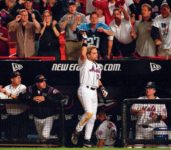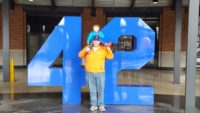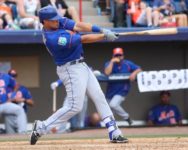
Thanks to three people, Anthony Scaramucci, Tony Lauto, and another in identified buyer (Oliver Stone?), Mike Piazza‘s 9/11 jersey is safe. The trio agreed that the jersey will forever rotate between Citi Field, the 9/11 Museum, and the Baseball Hall of Fame. These three people stepped up and did what was right and what was needed.
They had to step up because Mets ownership wouldn’t. As Kevin Kernan of the New York Post reported, the Mets never made a bid for the jersey.
To be fair, let’s not revisit the past here. We don’t know why the jersey was sold. It might’ve been the result of the financial troubles the Wilpons experienced as part of the Madoff scandal. It could’ve been an oversight. It’s possible no one realized the importance of the jersey. Maybe, just maybe, it was never supposed to be sold in the first place, but it was due to oversight. Fact is we’ll never know why it was sold. Most agree that in retrospect, it was wrong to sell the jersey. The Mets organization admitted as much in their statement to the New York Post stating, “We made a mistake in selling the jersey and Jeff [Wilpon] called Mike [Piazza] to express our regret in doing so.”
With the jersey up for sale, the Mets got that rare opportunity to right a wrong. They chose not to do so. They didn’t despite Jeff Wilpon assuring Piazza the Mets contacted the seller and were “making a concerted effort to get the jersey back.” They didn’t. Instead, they let someone else step in and purchase it.
At this point, it’s inexcusable. They told their newly elected Hall of Famer, they were going to make a concerted effort, and they didn’t. They got lucky because three people not only purchased it, but also agreed it should be on permanent display instead of in one of their homes. The thing is as the owners of that jersey that was their right. That was what the Mets risked.
At this point, we just have to ask,”Why?”
Why didn’t the Mets realize the jersey’s importance in the first place? Why didn’t they make an effort to buy the jersey? Why did they not keep their promise to Piazza? Why didn’t they understand what the jersey meant to the fans? Why were they willing to let the jersey to possibly be sold to someone who didn’t feel the obligation to display the jersey publicly?
The answer to all of these questions, and many more is, at the end of the day, baseball is a business. The owners only care about the fans to the extent that they want to create an environment suitable enough for them to spend as much of their disposable income on the team as possible. To Mets ownership, the Piazza 9/11 jersey didn’t have any special meaning. Rather, it was a jersey: (1) that could be sold for a profit; and (2) whose current purchase price was cost prohibitive. Pure and simple, these were business decisions.
The Mets will continue to make business decisions like they’ve always done. They’ll sell bricks which line the outside of Citi Field, but they won’t erect a Tom Seaver statue. They won’t sign a player like Yoenis Cespedes, despite the fans’ attachment to him, unless it is at a price suitable to them. For better or worse, that’s how the Mets operate.
And that’s all the Piazza 9/11 jersey decisions were to them – business decisions.

Deep down in each and every one of us is a snob. We prefer to see shows on Broadway instead of the community theater. We prefer our steaks to come from a steakhouse instead of a diner. We’d prefer to watch the Masters over the Shell Houston Open. There’s nothing wrong with a community theatre, diner steak, or the Shell Houston Open. In fact, they can all be quite good. However, deep down, we want to see the best of the best.
That’s part of the enduring legacy of Jackie Robinson.
No, this aspect of his enduring legacy is not discussed all that frequently. Mostly, it’s because it may be the least important part of his legacy. Robinson lived in a different world, even a different United States, than we do today. His breaking the color barrier pre-dated the end of segregation. Robinson playing for the Dodgers was not just important for baseball, but also for civil rights.
But make no mistake, it was important for baseball.
Because of Jackie Robinson’s breaking of the color barrier, we get to see the best players all play together and against one another. We get to see Ichiro Suzuki try to get to 3,000 hits this year. We get to see Carlos Beltran try to hit his 400th homerun this year. We just saw Bryce Harper hit his 100th homerun. CC Sabathia looks to record his 2,600 strikeout and move into the Top 25 in that category all time.
Each and every single one of these players, and the countless others not mentioned, are doing this at the highest level. As players, these players know they are truly exceptional because they are unequivocally doing this against the best players in the sport regardless of creed, race, or religion. As fans, we get to see the best players from around the world play baseball at the highest level. No matter what, we get to see the best of the best.
Thank you Jackie Robinson for making that and so much more possible.

On Wednesday, Logan Verrett pitched six scoreless innings against at the Miami Marlins. Verrett allowed three hits, two walks, and six strikeouts. It was a remarkable start for a pitcher who was never supposed to be here.
Heading into the 2015 season, the Mets declined to put Verrett on the 40 man roster thereby exposing him the the Rule 5 draft. He was selected by the Orioles, who waived him when it was apparent he was not making their team. He was picked up by the Rangers, who made their Opening Day roster.
In very limited duty for the Rangers Verrett struggled. He pitched nine innings in four appearances with a 6.00 ERA and a 1.667 WHIP. Verrett was offered back to the Mets, who accepted him back and sent him to Triple-A.
Verrett first came up with the Mets in June to help an exhausted bullpen. He would pitch 12.1 innings over the course of six appearances. He had a sterling 0.73 ERA and 0.649 WHIP. Batters were only able to hit .100/.178/.100 against him. He recorded his first save. Despite this stellar performance, he would be sent back down to the minors to make room for Jenrry Mejia, who was returning from his first PED suspension.
In Verrett’s second stint with the Mets in August, he would further prove his value. With the Mets needing to keep their young pitching staff fresh for the postseason, especially Matt Harvey, Verrett was called upon to make some spot starts. In his first start, he threw eight shutout innings in Coors Field of all places. He would follow that up with a couple a relief appearances and another strong spot start against the Marlins.
In total, Verrett would pitch in 14 games with the Mets making four spot starts. He was 1-1 with one save, a 3.03 ERA, and a 0.879 WHIP. In a season of incredible performances from a myriad of players, it’s easy to overlook Verrett’s contributions.
Then again, it’s been easy to overlook Verrett. In an organization that seemingly churns out nothing but pitchers throwing 95 MPH plus striking people out left and right, Verrett uses all four of his pitches, including a 91 MPH, to get outs. While each and every Mets draft pick gets attention, he simply flew under the radar honing his skills and becoming a better pitcher. Perhaps that is why he became the first ever draft pick from the Sandy Alderson regime to play in the majors.
In 2016, Verrett made the Opening Day roster, and he’s back to doing what he does best – pitching in whatever role the Mets need. In his spot start in place of the ailing Jacob deGrom, Verrett threw six shutout innings. Not only did he help prevent the Mets from getting swept by the Marlins, but he also pitched somewhat deep into the game to give a fatigued Mets bullpen some rest.
As we know, the Mets never intended to have Verrett start that game. Frankly, no one thought he would pitch a game for the Mets. However, because the Mets got lucky with the Orioles and Rangers overlooking how good he truly was, like the Mets once did themselves, Verrett is pitching in the majors showing the world what a truly talented pitcher he is.
No one is going to overlook him ever again.

On April 15, 1997, President Clinton attended a Mets-Dodgers game in Shea Stadium. He was there to commemorate the 50th Anniversary of Jackie Robinson breaking the color barrier. During the pre-game tribute, it was announced that 42 would be retired throughout baseball. Afterwards, a diverse group of Mets players would play in a game against a group of diverse Dodgers players. Can you name the Mets starting lineup on this momentous day? Good luck!

During Spring Training, Travis Taijeron introduced himself to many Mets fans by hitting .368/.432/.658 with two homeruns and 11 RBI. He played so well he was awarded the John J. Murphy Award, which is given to the top rookie in his first ever Spring Training.
It’s somewhat ironic that Taijeron wins that award as the 27 year old’s chances of ever playing for the New York Mets dwindle by the day.
In Taijeron’s major league career, he has only played the outfield. As Mets fans already know, the major league club is saturated with outfielders. In fact, the Mets have two major league caliber starters, Juan Lagares and Alejandro De Aza, as reserves. The Mets major league depth, and the fact that Taijeron is not on the 40 man roster makes it highly unlikely he will get called up to the majors either this year or in subsequent years.
No, in order for Taijeron to put himself into position to ever be called up to the majors, he’s going to have to become a more versatile player. It’s what the Mets are working on now with Taijeron’s AAA teammate Matt Reynolds. It’s a big reason why Eric Campbell made the Opening Day roster. In his short major league career, Campbell has played every position but pitcher, catcher, and centerfield. By the way, Campbell has worked at being capable enough behind the plate to become an emergency catcher.
So, if Taijeron ever wants to play in the majors, he’s got to pick up a first baseman’s mitt. He has to work on the position whenever he can. He needs to show the Mets organization that he is more than just an outfielder. He needs to show them he can be a versatile part of a major league bench. These are the types of things a 27 year old minor league player, who was drafted in the 18th round, needs to do.
Fortunately for him, if he becomes proficient. The Mets have no prospect standing in his way from playing some AAA games at first. The current AAA first baseman is Marc Krauss, who is nothing more than minor league depth. He’s a career .187/.255/.324 major league hitter. There is no scenario in which he ever plays for the Mets.
However, with the way Taijeron hits, he could play in the majors. Last year in AAA, he hit .274/.393/.536 with 25 homeruns and 71 RBI. His season was good enough to earn him an invitation to Spring Training where he made the most of his opportunities. He showed the Mets he has pop in his bat, and he can play the outfield well. Now, he just has to show them he can play one other position.
The Mets organization has some interest in seeing Taijeron play first base. It would permit Reynolds to play some outfield as he tries to become more versatile himself. With respect to Taijeron, the Mets could have a bench bat that can draw walks and hit for some power. As such, putting Taijeron at first would permit the Mets to extract the most value possible out of two prospects. Therefore, allowing Taijeron to play first would be in the Mets’ best interests.
Taijeron has real talent, which may or may not translate to the majors. However, we will never know if it could unless he makes himself versatile enough for the Mets to call him up to the majors. It’s time for Taijeron to put on a first baseman’s mitt.
Editor’s Note: this first appeared on metsminors.net

After Johan Santana threw 134 pitches on a surgery repaired shoulder to throw the first no-hitter in Mets history, Terry Collins was in tears. He seemed distraught. In the post-game press conference, Collins called Santana his “Hero,” and he was prescient in saying:
I’m very excited for him, but in five days, if his arm is bothering him, I’m not going to feel good.
As we know, even though Santana would make 10 more starts, his career effectively ended that night. He would need another shoulder surgery in the offseason. Between that surgery and other injuries, Santana has never pitched in another big league game.
When Collins was interviewed by Phil Taylor of Sports Illustrated three years later, Collins expressed his remorse. He would say, “It was without a doubt, the worst night I’ve ever spent in baseball.” Now, no one really knows what effect this game had on the need for Santana to have a second surgery. However, for his part, Collins thinks the no-hitter had a lot to do with it:
I was aware of what the wear and tear of that night could do to him, and basically, the worst-case scenario happened. To throw that amount of pitches with that much pressure and that much adrenaline going, it can beat you down. And it did.
If Collins truly believes that, it makes what he did with Jim Henderson all the more indefensible.
Henderson has come a long way to get here. He’s had two shoulder surgeries himself. He fought against all odds to make the Mets Opening Day roster. Not only did he make the roster, he quickly established himself as a very important part of the Mets bullpen.
So far this year, Henderson has pitched in five of the eight games the Mets have played. On Tuesday, he threw 34 pitches, which was the most he’s ever thrown in one game. Wednesday was a day game. The Mets added Rafael Montero to the roster so the Mets would have a full bullpen for the game. With the score tied 0-0 in the seventh inning, Collins put Henderson in the game.
Before Wednesday’s game, Henderson’s fastball averaged 95 MPH. On Wednesday, he was sitting around 89 MPH. He allowed a single and two hits before Collins pulled him from a game he shouldn’t have entered in the first place. Collins excuse?
TC: "Henderson said before the game that he felt great."
— Steve Gelbs (@SteveGelbs) April 13, 2016
It’s difficult to believe that Collins used this as a justification. He says he is troubled by Santana’s no-hitter, and he thinks it had a profound impact on effectively ending his career. Why would he willingly do the same thing again with another player? Why would he go to Henderson when there were other, fresher options? It doesn’t make sense.
It should be noted that Collins had a different tone in Wednesday’s press conference than Santana’s. Collins was fired up. There was no hint of him fearing for Henderson’s future.
Collins thought this was a must-win game, but it’s a stretch to believe he would sacrifice a player’s health for it. Collins said he was desperate, but there has to be a line. Collins might’ve wanted to respond to people questioning the Mets effort, but putting a player’s health and career in doubt, you prove nothing.
At the end of the day, Terry Collins has shown he has learned nothing. While we all understood him leaving Santana in, there was no excuse for pitching Henderson there. Collins could’ve ended someone’s career for what really was just another April game. Overall, Mike Vaccarro put it best when he chastised Collins:
Shame on Terry Collins. That wasn't just reckless game managing, but it put his pitcher's health in peril. #Mets
— Mike Vaccaro (@MikeVacc) April 13, 2016
Collins has had some nice moments as the manager of the Mets. Wednesday wasn’t one of them. Collins once called Santana’s no-hitter the worst night of his baseball life. Wednesday could’ve been the worst day of Henderson’s professional life, but Collins showed no remorse. Collins may be haunted by Santana’s no-hitter, but he has clearly showed he’s learned nothing from it.
Editor’s Note: this was first published on metsmerizedonline.com

I have a bone to pick with Sandy Alderson. No, it’s not the offense that isn’t hitting. They should hit eventually. Well, we at least hope they will. No, it’s when Alderson dubbed Mets fans “Panic City.”
Let’s remember the context of that gem. The Mets were one game over .500, lost six of their last 10, and were 3.5 games behind the Nationals. They had allowed 14 more runs than they had scored. The Mets had scored the third fewest runs in baseball. The Mets had gone from seven games over .500 with a 4.5 game lead in the division (5.0 games over the Nationals) to falling in the standings. The Nationals were hot, and they were getting better. The Mets were seemingly falling apart while their General Manager was mocking the fans.
Funny thing is the Mets got worse offensively after that. It got to the point where fans were EXPECTING Clayton Kershaw to pitch a perfect game. Not too long after that, the Mets got healthy, made some trades, ran into a cushy August schedule, and they took off. Panic City was forgotten.
Until now.
The Mets are grossly underperforming now. In five of the Mets six games, they’ve scored three runs or less. Terry Collins is batting low OBP guys in front of high OBP guys, and he’s stacking lefties (yes, with Neil Walker‘s L/R splits, he’s effectively a lefty). Mets fans are annoyed as well they should be. But no, that’s not how it’s characterized. Because of Alserson’s comments, we’re “panicking”:
Collins on #PanicCity fretting #Mets' 2-4 start: "It's drama here. It's not drama in Milwaukee. It's not drama in Houston. It's drama here."
— Anthony DiComo (@AnthonyDiComo) April 12, 2016
can't believe the panic i'm hearing out of ny/nj/conn over 2-5. mets will be fine.
— Jon Heyman (@JonHeyman) April 13, 2016
Panic City, assemble!
— Matt Ehalt (@MattEhalt) April 10, 2016
Everybody’s a comedian.
Look, no matter what happens from here on out whenever the Mets have a tough stretch this fan base is going to be mocked for panicking. Honestly, I do not know one Mets fan panicking. Not one. I know if people raising legitimate concerns about a lineup that strikes out a lot and doesn’t have high OBP. But that’s not panic, that’s reality.
I haven’t heard one person declare the season over, demand a trade, or call for Collins to be fired. There’s no panic. There’s just really justifiable frustration over a team that’s not hitting, losing to bad teams, and wasting some good pitching performances. No, Mets fans are colored as being unreasonable and overly reactionary.
We will never see the article about how right the Mets fans were in 2015. We will not see how that the fans were 100% right in their complaints. We will not see how the fans were right about demanding that Michael Conforto be called up. However, we will see articles and tweets demeaning the fanbase once again calling them “Panic City” as if Mets fans should enjoy really bad offensive baseball.
It’s all because Alderson thought he was hilarious in demeaning Mets fans one day when they were irritated watching an inept offensive club ruining start after start. Apparently, realizing a team that finds runs hard to come by is panicking. A fan base that wants their General Manager is panicking. Apparently, not being happy with a team playing poorly against a weak early schedule is panicking.
Thanks for that Sandy.

I have a bone to pick with Sandy Alderson. No, it’s not the offense that isn’t hitting. They should hit eventually. Well, we at least hope they will. No, it’s when Alderson dubbed Mets fans “Panic City.”
Let’s remember the context of that gem. The Mets were one game over .500, lost six of their last 10, and were 3.5 games behind the Nationals. They had allowed 14 more runs than they had scored. The Mets had scored the third fewest runs in baseball. The Mets had gone from seven games over .500 with a 4.5 game lead in the division (5.0 games over the Nationals) to falling in the standings. The Nationals were hot, and they were getting better. The Mets were seemingly falling apart while their General Manager was mocking the fans.
Funny thing is the Mets got worse offensively after that. It got to the point where fans were EXPECTING Clayton Kershaw to pitch a perfect game. Not too long after that, the Mets got healthy, made some trades, ran into a cushy August schedule, and they took off. Panic City was forgotten.
Until now.
The Mets are grossly underperforming now. In five of the Mets six games, they’ve scored three runs or less. Terry Collins is batting low OBP guys in front of high OBP guys, and he’s stacking lefties (yes, with Neil Walker‘s L/R splits, he’s effectively a lefty). Mets fans are annoyed as well they should be. But no, that’s not how it’s characterized. Because of Alserson’s comments, we’re “panicking”:
Collins on #PanicCity fretting #Mets' 2-4 start: "It's drama here. It's not drama in Milwaukee. It's not drama in Houston. It's drama here."
— Anthony DiComo (@AnthonyDiComo) April 12, 2016
can't believe the panic i'm hearing out of ny/nj/conn over 2-5. mets will be fine.
— Jon Heyman (@JonHeyman) April 13, 2016
Panic City, assemble!
— Matt Ehalt (@MattEhalt) April 10, 2016
Everybody’s a comedian.
Look, no matter what happens from here on out whenever the Mets have a tough stretch this fan base is going to be mocked for panicking. Honestly, I do not know one Mets fan panicking. Not one. I know if people raising legitimate concerns about a lineup that strikes out a lot and doesn’t have high OBP. But that’s not panic, that’s reality.
I haven’t heard one person declare the season over, demand a trade, or call for Collins to be fired. There’s no panic. There’s just really justifiable frustration over a team that’s not hitting, losing to bad teams, and wasting some good pitching performances. No, Mets fans are colored as being unreasonable and overly reactionary.
We will never see the article about how right the Mets fans were in 2015. We will not see how that the fans were 100% right in their complaints. We will not see how the fans were right about demanding that Michael Conforto be called up. However, we will see articles and tweets demeaning the fanbase once again calling them “Panic City” as if Mets fans should enjoy really bad offensive baseball.
It’s all because Alderson thought he was hilarious in demeaning Mets fans one day when they were irritated watching an inept offensive club ruining start after start. Apparently, realizing a team that finds runs hard to come by is panicking. A fan base that wants their General Manager is panicking. Apparently, not being happy with a team playing poorly against a weak early schedule is panicking.
Thanks for that Sandy.

After the Mets bullpen had to pitch 7.1 innings on Monday with Steven Matz‘s terrible start, and Logan Verrett having to come out of the bullpen to start in place of Jacob deGrom, the Mets were forced to make a move to add a pitcher to the roster.
There were plenty of good options available to them.
The Mets could’ve utilized deGrom’s paternity leave and called up Rafael Montero. However, the Mets didn’t want to do that because they then couldn’t backdate a potential deGrom DL stint to last Saturday. The Mets could’ve just placed deGrom on the DL, but for some reason they do not appear ready to do that. Apparently, that April 19th game against the Phillies is a must win, and you need deGrom to pitch in that game if at all possible.
No, the Mets decided to demote a player. Looking over the roster, the only pitcher who realistically could be demoted is Hansel Robles. He seems like a natural choice as he pitched 2.2 innings on Monday, and he could use an extra day or two. If Montero falters, the Mets could recall Erik Goeddel or Sean Gilmartin to take his place on the roster.
In this scenario, Robles would have to stay in the minors for 10 days unless the Mets put deGrom (or someone else) on the DL. Given Robles’ current role, losing him for 10 days would be palatable. Montero, Goeddel, or Gilmartin could easily be the long man and/or last man in the bullpen.
Instead of the Mets following the reasonable course of action, they determined it was in their best interests to demote Eric Campbell. In essence, the Mets decided to go with the worst possible choice.
Now,there is nothing wrong per se with demoting Campbell. He’s a career .230/.315/.325 hitter. He has good attributes as a player, but nothing that Campbell has done in his career would ever prevent him from being demoted. However, if he’s being demoted, it should be because the Mets are calling up another position player like Matt Reynolds, not because they are adding a pitcher to the roster.
The Mets demoting Campbell for Montero shortens the Mets bench. In a world where you have David Wright on your team, you should never shorten your bench. On any given day, Wright can wake up sore and not be ready to play. If that happens, not only are you down another player, but you also have no infielders on your bench.
By the way, the Mets are playing a day game after a night game. Terry Collins has said there’s no hard-and-fast rule stating Wright must sit a day game after a night game. However, it’s also true that the Mets have so far refrained from playing Wright in a day game after a night game. No one knows how his back will respond to it. No one knows if he will be able to get loose in time to play a full nine innings.
Instead of taking this into account, the Mets thought it would be best to potentially have no infielders on the bench. The Mets thought it would be best to realistically only have two options on the bench for Wednesday’s game (Collins is loathe to pinch hit with his catcher). Also, apparently, the Mets do not foresee the need to have more than two pinch hitters available in a game where the starting pitcher hasn’t pitched in almost a month and wasn’t stretched out in Spring Training. No, the Mets are setting forth a gameplan where they will have Verrett go deep in the game, and they will be alright with just two bench players. What could go wrong?
The Mets are in the midst of a four game losing streak and would rather potentially sacrifice the the last game of the homestand to give themselves the best possible shot of winning a game against a terrible Phillies team in Philadelphia. The Mets apparently didn’t learn their lesson on Monday about the perils of having a shortened roster.
Overall, the Mets put themselves in a tough position all because they’ve deemed an April game in Philadelphia a must win. Why else wouldn’t you put an injured pitcher who is already missing a start and bullpen sessions on the DL?

Tonight’s start by Noah Syndergaard was good. Why do I describe it as good? Because no matter what adjective you would pick to describe his start would be grossly underselling it, so you might as well just go with good. Too bad the Mets offense can’t even be described as putrid. Otherwise, Syndergaard and the Mets might’ve gotten the win tonight.
Syndergaard just dominated the Marlins like he did the Royals – like he’s going to do to the rest of baseball this year. Syndergaard went seven innings allowing seven hits, one earned, one walk, and 12 strikeouts. His ERA actually increased to 0.69.
However, as good as Syndergaard was, he still needed some help. Derek Dietrich would start the inning with a leadoff double, and he would wind up running the Marlins out of the inning. After a ground out and line out, Ichiro Suzuki singled to short, and Dietrich did a poor Eric Hosmer impersonation. Lucas Duda nailed him easily at the plate. Even if Ichiro would’ve been ruled out on replay, it was good to see Duda get some measure of redemption.
However, despite Syndergaard’s domination, the Mets still lost. They lost because the Mets still are not hitting or scoring runs.
The only run was scored on a Duda first inning RBI single. After that, it was pretty much nothing. At least tonight, they had the excuse of a dominant Jose Fernandez for five innings. Yoenis Cespedes gave one a ride in the third, but it was knocked down by the 29+ MPH winds blowing in from left field.
The turning point was Dee Gordon‘s eighth inning sixteen pitch at bat against Jim Henderson. Gordon would single to left. Henderson would walk two of the next three to leave the bases loaded. Henderson just lost his control, and he almost hit Giancarlo Stanton in the head. Jerry Blevins came into the game, and Don Mattingly used Martin Prado to pinch hit. Prado would get the game winning sac fly, and the Marlins would win 2-1.
The Mets have now lost four in a row and are 1-4 at home.
Game Notes: Terry Collins allowed Michael Conforto to hit against a lefty with runners on first and second with one out in the sixth. He grounded into an inning ending double play. Cespedes had another good night at the plate going 1-3 with a walk. Collins ignored the fact that Henderson is playing his first full season since shoulder surgery:
Jim Henderson with his career-high 34th pitch. And it's a walk to load the bases with one out. TC to the bullpen.
— Adam Rubin (@AdamRubinMedia) April 13, 2016
